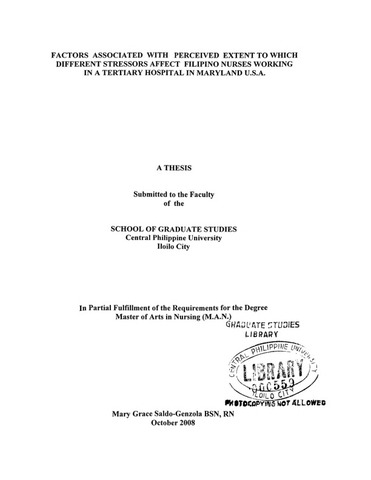Factors associated with perceived extent to which different stressors affect Filipino nurses working in a tertiary Hospital in Maryland U.S.A.

Page views
584Date
2008Author
Thesis Adviser
Defense Panel Chair
Share
Metadata
Show full item record
Abstract
The study attempted to determine the perceived extent to which different sources of stress related to the nursing profession has affected Filipino nurses working in a tertiary hospital in Baltimore, Maryland, USA. It further aimed to determine if the perceived extent of effect of the different stressors vary according to the selected personal and work-related characteristics of the nurses such as sex, age, civil status, employment status of spouse, number of children, number of children seven years old or less, number of years in the US, number of years in the hospital, and area of assignment. Furthermore, the study also aimed to determine if there is a significant relationship between these characteristics and perceived extent of effect of the different stressors on the six major stress categories mentioned in the preceding part of this study.
The hypothesis that the nurses’ perception on the extent in which the identified stressors affect them do not vary according to sex, age, civil status, employment of spouse, number of children, number of children seven years or less, number of years in the US, number of years in the hospital, and area of assignment was tested. The study also hypothesized that there is no significant relationship between the selected personal and work-related characteristics of the nurses and the perceived extent of effect on them of the different sources of stress.
The study was conducted on December 2007 and January 2008 in a tertiary hospital in Baltimore, Maryland USA, with 56 sample staff nurses as respondents. A questionnaire was administered to the sample nurses after their consent was obtained.
The results of the study showed that the majority of the respondents were female, married, and middle-aged. Most of those who were married had a working spouse, one to two children, one of whom is below seven years old. Most of them have been staying in the US for more than five years and have been working in the hospital for one to three years.
Among the four specific indicators of interpersonal conflict stressors, lack of teamwork and department coordination was perceived to have the highest proportion of nurses, while nurse-physician problems was the least mentioned stressors.
In relation to patient care, routine procedures was reported to have least affected the nurses, while the top three stressors which were perceived to have affected them were: high risk of contracting disease from patients, demanding patients, and patients who are acutely ill, critical or unstable.
Lack of knowledge, unfamiliar situations/diseases entities, and insufficient time for orientation were identified by the nurses as their top three stressors under the category knowledge and skills. On the other hand, among the stressors classified under health care environment category, inadequate hospital supplies, insufficient work space/work area, and unpleasant odors secondary to poor ventilation were identified by the nurses as the top three.
The data further show that the identified top three stressors under administrative support and rewards were lack of supportive superiors and administrators, lack of security of tenure from job, and inadequate pay, lack of benefits while the least stressor among the eight subcategories is lack of praise, recognition, appreciation.
All the six major stressors have been reported to have affected the nurses to a moderate extent. The overall perceived extent of effect of the six major stressors on the nurses was also moderate.
The data further show that the perceived extent of effect of each of the six identified stressors did not significantly vary according to sex, age, civil status, employment of spouse, number of children, number of children below seven years, length of stay in the US, length of service at the hospital, and area of assignment. Irrespective of sex, age, civil status, employment of spouse, number of children, number of children below seven years, length of stay in the hospital, and area of assignment, the perceived extent of effect on the group by the identified stressors was moderate.
The data further reveal that no significant relationship exists between each of the selected personal and work-related characteristics of the nurses and the perceived extent of effect on the group of the six identified stressors. The nurses’ sex, age, civil status, employment of spouse, number of children, number of children below seven, length of stay in the US, length of service in the hospital, and area of assignment have no significant bearing on the perceived extent to which stressors related to interpersonal conflicts, management of unit, patient care, knowledge and skills, healthcare environment and administrative support and rewards.
Conclusions
Nurses, wherever they are employed, experience a lot of stress. The Filipino nurses working in a tertiary hospital in Maryland USA are not exempted from the same stressors. The stressors are usually categorized into: interpersonal conflicts, management of unit; patient care; knowledge and skills; healthcare environment; and administrative support and rewards.
Lack of supportive superiors and administrators and inadequate staffing have caused the nurses the most stress, while in relation to patient care, the risk of contracting disease from patients, lack of teamwork, and poor coordination with other department were perceived to have affected the nurses the most. Nurse-physician problems, however, were no longer viewed as a major source of stress by the nurses. Problems with the head nurse/supervisors, however, are still common sources of tension. This may be so because their contact with supervisors is direct and supervisors. In relation with physicians, conflicts may be rare because physicians are visible most of the time to answer patient care related questions.
The perception that the identified stressors moderately affected the nurses indicate that in general, the Filipino nurses are flexible and adaptable to any situation and environment. They seem to have an added character or attitude, which are tolerance and compassion, which make them stronger and resistant to stress. Moreover, irrespective of who they are and what their work conditions are, Filipino nurses experience stress, like most working nurses. Lastly, the perceived moderate effects on them of the different identified stressors confirm Filipino nurses’ positive work attitudes, flexibility and adaptability.
Description
Abstract only
Suggested Citation
Genzola, M. G. S. (2008). Factors associated with perceived extent to which different stressors affect Filipino nurses working in a tertiary Hospital in Maryland U.S.A. (Unpublished Master's thesis). Central Philippine University, Jaro, Iloilo City.
Type
ThesisSubject(s)
Keywords
Department
School of Graduate StudiesDegree
Master of Arts in NursingShelf Location
GSL Theses 610.73072 G289
Physical Description
xv, 95 leaves



